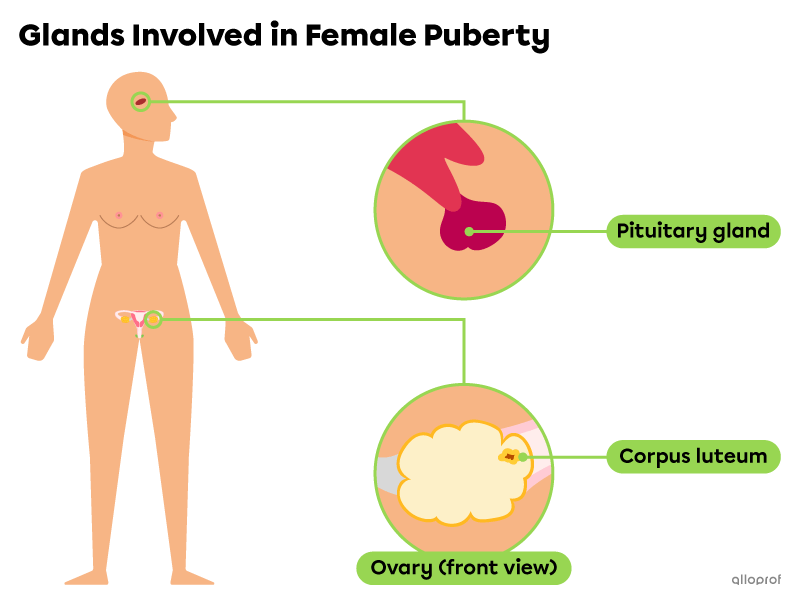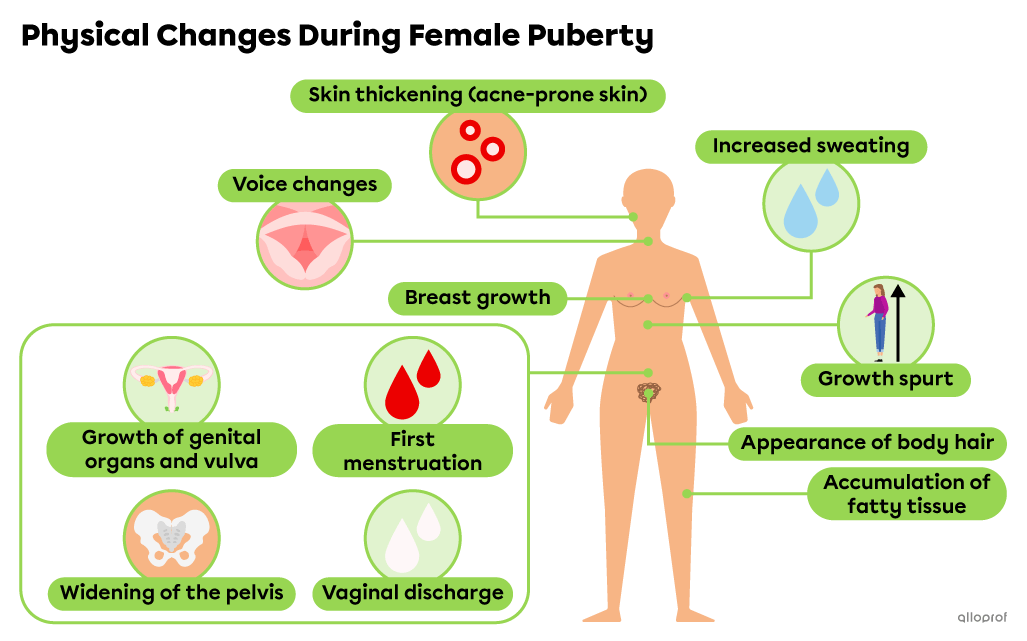Puberty is a period of hormonal, physical and psychological changes in pre-adolescents and adolescents.
The purpose of puberty is to prepare the body for reproduction. In girls, puberty occurs between the ages of 8 and 16 and lasts about 4 years.
Puberty is triggered by glands and their hormones.
-
The glands are organs that can make and secrete hormones or enzymes. They control the metabolic activities of the body and promote homeostasis.
-
Hormones are substances secreted by glands. They are often called chemical messengers that cause reactions in the cells of other organs or glands.
Hormones are secreted by the body’s glands throughout life to ensure that the body functions properly. During puberty, some glands are stimulated more than others to produce the amount of hormones required for adequate development.
The following table and images identify and describe the glands involved in female puberty.
| Gland | Description |
|---|---|
| Pituitary gland | The pituitary gland is a small gland located in the brain. |
| Ovaries | The ovaries are glands of the female reproductive system. |
| Corpus luteum | The corpus luteum is a small gland that forms in the ovary immediately after ovulation. It is present only for a few days per cycle, and then decays if no fertilization occurs. |

The following table describes the hormones involved in female puberty.
| Hormone | Description |
|---|---|
| Growth hormone | The growth hormone (GH) is secreted by the pituitary gland. It acts on the whole body, but mainly on the bones. GH leads to growth spurts and other physical changes during puberty. |
| Follicle-stimulating hormone | Follicle-stimulating hormone (FSH) is secreted by the pituitary gland and acts on the ovaries. FSH stimulates the ovarian follicles to mature. |
| Luteinizing hormone | Luteinizing hormone (LH) is secreted by the pituitary gland and acts on the ovaries. It enables ovulation and the formation of the corpus luteum. |
| Estrogen | Estrogen is secreted by the ovaries and acts on the entire body. It is responsible for many physical and psychological changes during puberty. |
| Progesterone | Progesterone is secreted by the ovaries, but more specifically by the temporary corpus luteum inside an ovary. This hormone acts on the uterus, preparing the uterine wall to receive an embryo. |
Note: A very small amount of testosterone is also secreted by the ovaries.

In addition to playing a key role in female puberty, follicle-stimulating and luteinizing hormones, estrogen and progesterone are heavily involved in oogenesis, the ovarian cycle, the menstrual cycle, pregnancy and menopause.
Menopause is when menstruation stops, usually around the age of 50.
The physical changes are mainly caused by two types of hormones: estrogen and growth hormone (GH). These changes are often classified as primary sexual characteristics, which involve the reproductive system, and secondary sexual characteristics, which involve the rest of the body. Here are the main physical changes that occur during female puberty.

Growth of the genital organs and vulva
All the structures of the reproductive system and vulva grow and change during puberty. For example, the labia minora and majora become longer. Their new shape protects the opening of the vagina.
The appearance of vaginal discharge
Vaginal discharge, also called leukorrhea, is a whitish fluid released from the vagina. It cleans the vagina and protects it from harmful microorganisms.
First menstruation
The first menstruation marks the beginning of the menstrual cycle. During the first 2-3 years, cycles are usually irregular and the production of oocytes is unpredictable.
Breast growth
Breast growth is one of the first signs of puberty onset. Fully formed breasts allow for the production of breast milk following pregnancy.
Widening of the pelvis
The pelvis widens to give it a shape suitable for pregnancy and childbirth.
Accumulation of fatty tissue
During puberty, fatty tissue accumulates in the hips and thighs.
Growth spurt
During puberty, an adolescent can grow about 8 to 10 cm per year. About 2 years after her first menstruation, she will reach her adult height and stop growing for the rest of her life.
Voice changes
Like the rest of the body in a growth spurt, the larynx and vocal cords grow during puberty. This changes the tone of the voice, making it deeper.
Increased sweating
During puberty, the sweat glands develop which increases sweating, mainly in the armpits and pubic area. Sweating plays a key role in regulating body temperature.
The appearance of body hair
Hair growth in the armpits, on the legs and on the pubic area increases. The hair, which was previously very fine and pale, becomes thicker and darker.
Skin thickening
During puberty, the skin becomes thicker. In addition, the sebaceous glands produce more sebum, a substance that protects the skin and keeps it moist. The excess sebum, along with other factors, can cause acne.
Growth spurts, voice changes, increased sweating, body hair growth and skin thickening are physical changes that also occur during male puberty.
In addition to the many physical changes, several psychological changes occur during puberty.
Desire for independence and autonomy
The desire for independence and autonomy can include making more decisions and taking on more responsibility. For example, wanting to get a job to earn spending money comes from a desire for independence and autonomy.
Identity search
The search for identity is a period of self-exploration and self-assertion. Personal interests and values are being forged and confirmed. An interest could be an activity such as sports, arts or any other enjoyable hobby. Respect, empathy and justice are examples of personal values.
Mood swings
Hormonal changes during puberty can cause emotions to change or become more intense. Emotions such as sadness or anger can be felt more intensely during a conflict with a friend, sibling, parent, etc.
Sexual desire
During puberty, the body prepares itself for reproduction. Sexual desire includes sexual attraction and/or romantic affection.
